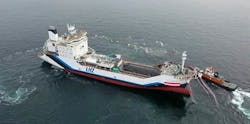World's first Liquefied Hydrogen Carrier docks in Australia from Japan
By Rod Walton, EnergyTech Senior Editor
A ship built by Kawasaki Heavy Industries to carry liquefied hydrogen (LH2) arrived in Australia to end its longer than expected maiden voyage from Japan this past weekend.
Kawasaki brought its brand new Suiso Frontier vessel into port at Victoria. It was touted as the a key success in the company’s Hydrogen Energy Supply Chain (HESC) pilot project and the “dawn of Australia’s H2 industry.
The vision of the HESC project is to produce carbon-neutral hydrogen through extraction of coal and biomass couple with the resulting CO2 emissions being captured and sequestered. Those in the H2 industry often calls this type “blue hydrogen” as opposed to “green hydrogen” which would be produced using carbon-free resources such as electrolyzers powered by wind or solar power.
Related stories
Ohmium, Hero Future Energies partnering on 1 GW in Hydrogen Electroylsis capacity
Kawasaki said the 225,000 metric tons of LH2 produced by the HESC project in a commercial phase would help reduce CO2 emissions by about 1.8 million metric tons per year. That second number is equivalent to the air pollution emitted by about 350,000 gas-powered automobiles, according to the company.
“In a commercial phase, the project will create 30,000 full-time jobs across the Gippsland and Mornington Peninsula regions over the life of the project,” reads the press release by Kawasaki. “During the Pilot Project, 99.999% pure hydrogen has been produced from Latrobe Valley coal and biomass via gasification, trucked to Hastings, cooled to -253 degrees and subsequently liquified to less than 800 times its gaseous volume to create highly valuable liquefied hydrogen.”
Gippsland and Latrobe Valley possess one of the world’s largest deposits of lignite, or brown coal. The HESC pilot will continue to test return trips between Japan and Australia.
The maiden voyage from Kobe, Japan to Victoria took about 16 days due to bad weather, according to reports. The test previously was delayed about a year due to the COVID-19 pandemic.
Hydrogen is the lightest element and is highly combustible. Although H2 is found abundantly in various things such as water, it is independently available and must be extracted through both electrolysis and steam reforming of methane gas.
The HESC Project Partners are: Kawasaki Heavy Industries, Ltd (KHI), Electric Power Development Co., Ltd. (J-POWER), Iwatani Corporation (Iwatani), Marubeni Corporation (Marubeni), AGL Energy (AGL) and Sumitomo Corporation (Sumitomo). Royal Dutch Shell (Shell), ENEOS Corporation and Kawasaki Kisen Kaisha, Ltd. (K-Line) are also involved in the Japanese portion of the project.
-- -- --
(Rod Walton, senior editor for EnergyTech, is a 14-year veteran of covering the energy industry both as a newspaper and trade journalist. He can reached at [email protected]).
EnergyTech offers Insights into the C&I Energy Transition, focusing how large-scale users are securing their energy needs. These include manufacturers, military bases, universities, data centers and other mission critical energy consumers.
About the Author
Rod Walton, EnergyTech Managing Editor
Managing Editor
For EnergyTech editorial inquiries, please contact Managing Editor Rod Walton at [email protected].
Rod Walton has spent 17 years covering the energy industry as a newspaper and trade journalist. He formerly was energy writer and business editor at the Tulsa World. Later, he spent six years covering the electricity power sector for Pennwell and Clarion Events. He joined Endeavor and EnergyTech in November 2021.
Walton earned his Bachelors degree in journalism from the University of Oklahoma. His career stops include the Moore American, Bartlesville Examiner-Enterprise, Wagoner Tribune and Tulsa World.
EnergyTech is focused on the mission critical and large-scale energy users and their sustainability and resiliency goals. These include the commercial and industrial sectors, as well as the military, universities, data centers and microgrids. The C&I sectors together account for close to 30 percent of greenhouse gas emissions in the U.S.
He was named Managing Editor for Microgrid Knowledge and EnergyTech starting July 1, 2023
Many large-scale energy users such as Fortune 500 companies, and mission-critical users such as military bases, universities, healthcare facilities, public safety and data centers, shifting their energy priorities to reach net-zero carbon goals within the coming decades. These include plans for renewable energy power purchase agreements, but also on-site resiliency projects such as microgrids, combined heat and power, rooftop solar, energy storage, digitalization and building efficiency upgrades.

